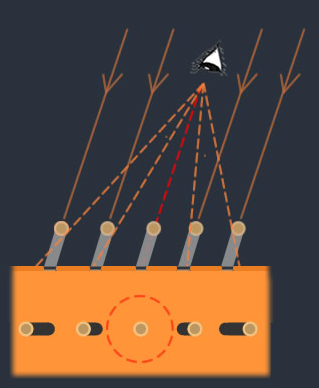OPOD - Shadow Hiding, California
OPOD - Shadow Hiding, California: Exploring the Phenomenon of Shadows Disappearing Near the Full Moon
Have you ever noticed that when the full moon graces the night sky, the landscape below seems devoid of shadows? It's a peculiar phenomenon that has intrigued sky watchers and photographers alike. In this article, we delve deeper into the concept of shadow hiding near the full moon, specifically focusing on a stunning image captured by Andrew Kirk over the Sierra Nevadas in California.
In the captivating wide-angle panorama captured by Andrew Kirk, we observe an intriguing paradox. While there are shadows present on the mountains at the left and right sides of the image, those shadows appear to point inward towards the moon. This peculiar optical effect can also be witnessed in wide-angle photographs taken on the moon itself, often leading to debates about the authenticity of those images.
Shadows, by their nature, are parallel tubes of darkness. However, due to perspective, they seem to converge towards the antisolar point (ASP), which is opposite to the position of the sun. In the image captured by Kirk, the full moon is situated within a mere 3° of the antisolar point. It is important to note that during August's "blue moon," the moon was not precisely at the ASP because its orbit is tilted approximately 5° relative to Earth's orbital plane around the sun.
When our line of sight aligns with the antisolar point, shadows behind objects become hidden from view. This creates a seemingly featureless landscape that appears brighter than its surroundings due to the absence of visible shadows. This phenomenon is known as shadow hiding or the opposition effect. Intriguingly, this same effect causes the full moon itself to appear brighter to us.
Andrew Kirk, the astute photographer who captured this mesmerizing image, has noticed that the shadow-free zone near sunset moves back and forth along the mountains with the changing seasons. This observation suggests that the angle of the antisolar point, relative to the moon and the landscape, varies throughout the year.
To better understand the concept of shadow hiding, let's visualize the line of sight along the sun's rays towards the antisolar point. This imaginary line, depicted in red, reveals how shadows become concealed behind the objects casting them. It's a fascinating phenomenon that alters our perception of the landscape and accentuates the brightness of both the moon and the shadow-free region.
In conclusion, the phenomenon of shadow hiding near the full moon is a captivating optical effect that has puzzled sky watchers and photographers for years. The paradoxical direction of shadows and the absence of visible shadows near the antisolar point create an otherworldly ambiance in landscapes bathed in the moon's ethereal glow. Thanks to Andrew Kirk's stunning image captured over the Sierra Nevadas in California, we are reminded of the intricate interplay between light, shadows, and celestial bodies. So, next time you find yourself gazing at the full moon, take a moment to appreciate the hidden world of shadows that lies just beyond its radiant surface.

Full Moon & Shadow Hiding - A full moon imaged over the Sierra Nevadas, California by Andrew Kirk. Images ©Andrew Kirk, shown with permission.

There are no shadows on the landscape close to the full moon. In the lower wide angle panorama there are mountain shadows at left and right. These shadows somewhat paradoxically appear to point inwards towards the moon. Wide angle views taken on the moon itself show similar contradictory shadow directions often upheld as 'evidence' that the shots were staged on Earth.
Shadows are all parallel tubes of darkness but perspective makes them appear to direct towards the antisolar point (ASP) opposite the sun. In this image the full moon is within 3° of the antisolar point. It was not at the ASP at August's "blue moon" because the moon's orbit is tilted ~5° relative to the plane of Earth's orbit around the sun.
When we look in the direction of the ASP shadows disappear behind the objects casting them. The landscape there appears featureless and is brighter than its surroundings due to the absence of visible shadow. The full moon itself is brighter to us for the very same reason - shadow hiding or the opposition effect.
Andrew Kirk has noticed the shadow free zone near sunset creep back and forth along the mountains with the seasons.

The line of sight (red) along the sun's rays, towards the antisolar point, has shadows hidden behind the objects casting them.
Note: this article has been automatically converted from the old site and may not appear as intended. You can find the original article here.
Reference Atmospheric Optics
If you use any of the definitions, information, or data presented on Atmospheric Optics, please copy the link or reference below to properly credit us as the reference source. Thank you!
-
<a href="https://atoptics.co.uk/blog/opod-shadow-hiding-california/">OPOD - Shadow Hiding, California</a>
-
"OPOD - Shadow Hiding, California". Atmospheric Optics. Accessed on November 26, 2024. https://atoptics.co.uk/blog/opod-shadow-hiding-california/.
-
"OPOD - Shadow Hiding, California". Atmospheric Optics, https://atoptics.co.uk/blog/opod-shadow-hiding-california/. Accessed 26 November, 2024
-
OPOD - Shadow Hiding, California. Atmospheric Optics. Retrieved from https://atoptics.co.uk/blog/opod-shadow-hiding-california/.